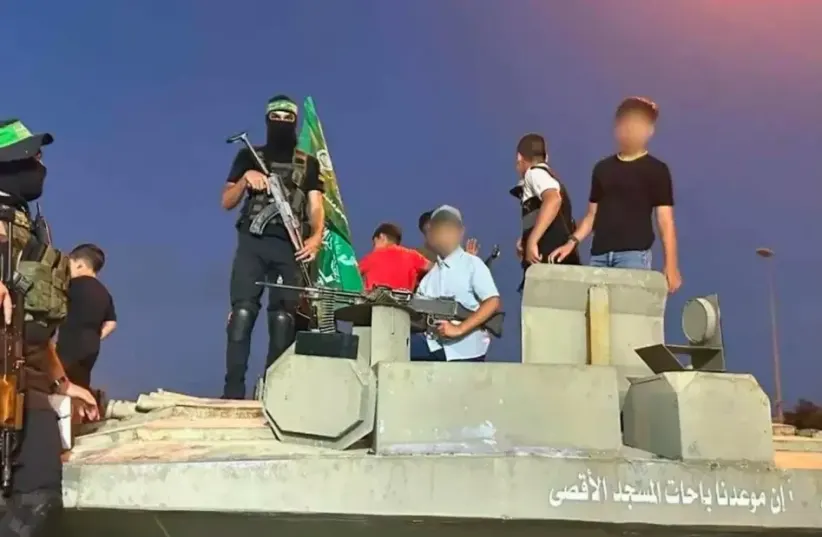The discovery that Hamas was using the headquarters of UNRWA in Gaza to recruit new members and also to store rockets and explosives as well as drones illustrates how the use of UN facilities is a key strategy of Hamas.
While this was likely hinted at before, due to the number of times the terrorist group’s members have been located in UN schools, for instance, the fact they targeted the agency’s headquarters shows how blatant this strategy has become.
It’s reasonable to conclude that Hamas views UN facilities as part of its command and control of Gaza. It basically mapped out these facilities and used them openly. It has used them systematically throughout the war.
The fact that the UN and UNRWA, in particular, have not condemned Hamas for this or put out statements daily mentioning how Hamas uses their facilities must raise questions about what the UN organizations know and when they found out.
There is no other terrorist or “armed group” in the world that has systematically used UN facilities the way Hamas has done in Gaza. The systematic use of schools, for instance, is a serious crime by Hamas against the people of Gaza. The need to remove it from these facilities is clear. Yet, throughout nine months of fighting, the terrorist group has increasingly used UN facilities and has not decreased their use.
The story of the Hamas exploitation of the UNRWA headquarters is symbolic. The complex is located in northern Gaza in Tel al-Hawa. The IDF found explosive devices and also a drone at the site. More concerning are the reports that it used this facility to recruit and rebuild itself. What this means is that Hamas viewed the UN site not only as a place to hide weapons and hide its fighters but also as a key part of its nexus in northern Gaza.
It viewed the UN facility as a unique place to be used to return to power. The fact that the UN did not condemn this or note it in statements is concerning.
Hamas use of hospitals as key command centers
THIS IS a reminder that when Hamas first sought to return to northern Gaza, it gathered hundreds of men in Shifa Hospital. Israeli forces raided the hospital in March, detaining hundreds of terrorists and killing others who fired on the IDF.
Hamas saw Shifa not just as a place to send a few men to hide but to bring hundreds of terrorists. Perhaps 1,000 Hamas terrorists were gathered in the large hospital compound and buildings nearby. This means that Hamas saw the hospital as key to its command and control of Gaza.
When the hospital was partly destroyed in March, and the Hamas and Palestinian Islamic Jihad members were removed, they didn’t disappear entirely. Hamas then moved into the UNRWA headquarters. It must have been believed in April and May that using the UN facility would enable it to return to power in northern Gaza.
It did not suspect that the IDF would return to operate there in the second week of July. Now, the second raid into this UN facility is completed. The military had operated in this area earlier in the year.
It’s important to see Hamas’s use of the UNRWA facility and Shifa as part of a larger context. It is not just by chance that Hamas moves into these places like it is a second Hamas. Its presence is considered normal in these places because Hamas is seen as the norm, as the “governing authority” by the UN and NGOs that never mention it by name in statements.
They usually call it an “armed group.” But the armed group sends men in civilian clothes through the doors of these facilities, and no one bars their way. This is because they are perceived either as welcome guests, partners, or as a mafia-like presence that the organizations cannot say no to.
Whatever the case, the fact that Hamas feels so secure in moving from the largest hospital in Gaza to the UNRWA headquarters and on to other places that should be protected for civilians illustrates the Hamas system in Gaza. This is not a rabble of Hamas men in civilian clothes who have been defeated. This is a system and part of how the terrorist group is planning to run Gaza in the future.
While it is being debated whether Hamas’s Gaza military leader Muhammed Deif was killed and what impact this may have on it, the use of the UN facilities and hospitals illustrates that the terrorist group has a long-standing plan and method that it is using to retain control of the embattled coastal enclave.
The IDF raids may set Hamas back a month or two here and there. However, the lesson of Shifa and the UNRWA headquarters is that the group returns in a month and begins setting up shop and recruiting and storing arms again.
Hamas is prepared for the long haul. It remains to be seen what its next strategic command and control node will become in northern Gaza. It has already brought ruin to the main hospital and main UNRWA facility. But Hamas has a map of other hospitals and UN facilities that form part of how it runs Gaza, and it is likely that it will move into these places as well.










